|
The Film

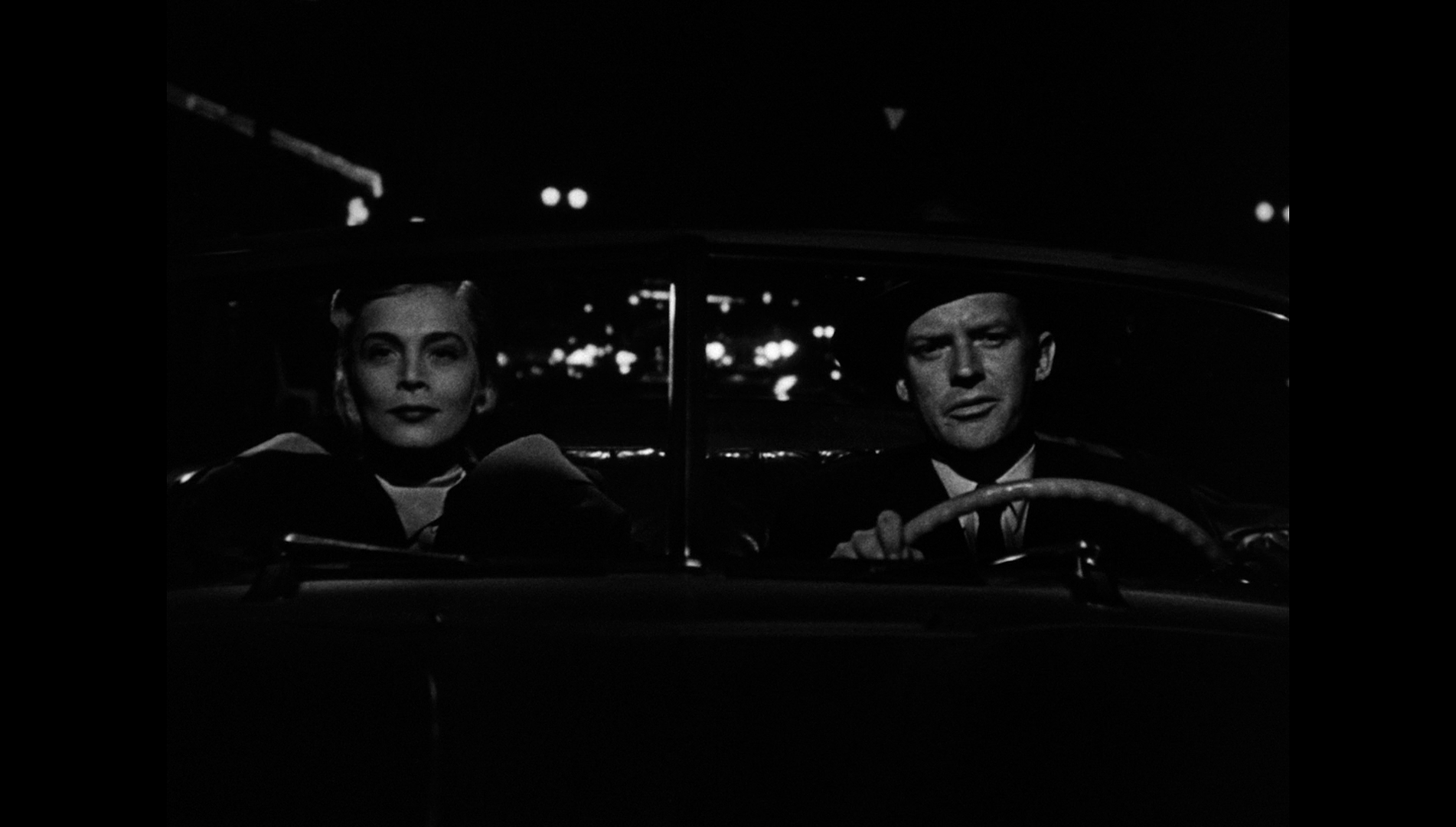 Too Late for Tears (Byron Haskin, 1949) Too Late for Tears (Byron Haskin, 1949)
Focusing on Jane and Alan Palmer (Lizabeth Scott and Arthur Kennedy), Too Late for Tears begins with the couple driving at nighttime to the home of some friends. Along the way, they see a car racing towards them. A bag is thrown from the vehicle as it passes the Palmers, landing in their car. Jane and Alan open the bag: it contains money, to the tune of $60,000. Finding themselves chased by another car from which they thankfully escape, they realise that the money was part of a ‘handover’, most likely intended for the second vehicle they encountered, and was passed into the Palmers’ car by mistake.
After much persuading, Jane convinces Alan to agree to keep the money for a week before they decide what to do with it. Returning home, Jane and Alan briefly entertain Alan’s single sister Kathy (Kristine Miller) before deciding to stash the money in a locker at the train station. Alan holds onto the ticket which will enable them to claim back the bag.
The next day, Danny Fuller (Dan Duryea) knocks on Jane’s door whilst Alan is out. Fuller claims to be a detective but soon reveals himself to be a hood: the money is his and he’s there to get it back. Jane arranges a meeting with Fuller and schedules to meet with the unknowning Alan at the same time: the plan is to persuade Alan to allow her and Fuller to keep the ticket which will enable them to collect the money from the train station. However, whilst on a gondola with Alan, Jane produces Alan’s service revolver. The gun goes off, killing Alan. Jane and Fuller dump Alan’s body in the river, and Jane persuades Fuller to dress in Alan’s clothes, thus providing her with an alibi. Claiming to Kathy and the police that Alan has left her for another woman, Jane draws Fuller into her deadly web by trying to enlist him in her plan to murder Kathy. However, a mysterious visitor arrives: Don Blake (Don DeFore), who claims to be a friend of Alan’s from his wartime service in the US Air Force.
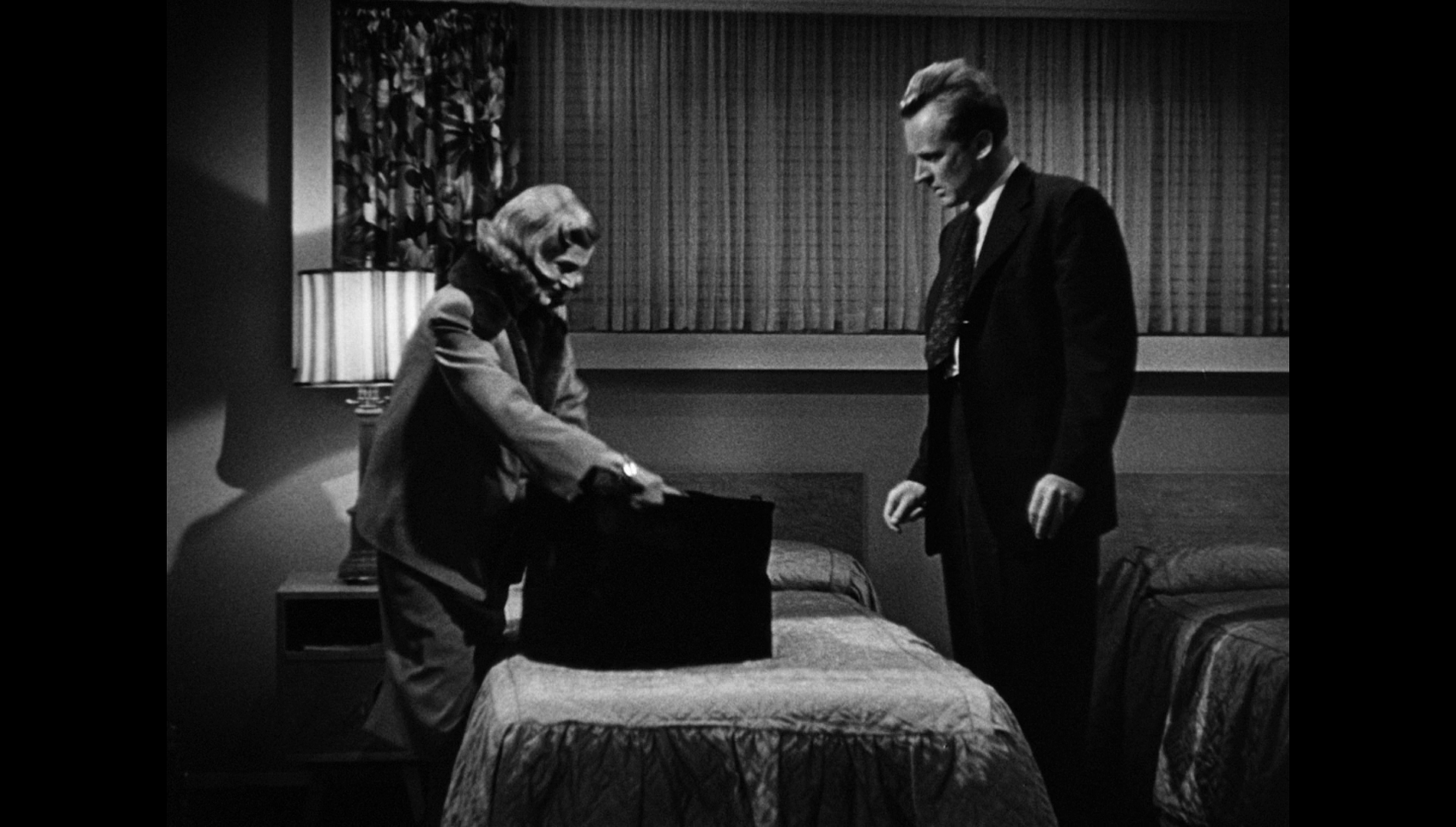 In his examination of thirteen films noir made by different studios, Ronald Schwartz asserts that Too Late for Tears is ‘perhaps the darkest noir I have seen in this series of films, both photographically and emotionally’ (Schwartz, 2014: 130). The picture is one of two films noir that Byron Haskin directed in his forty year filmmaking career: both of his films noir, Too Late for Tears and I Walk Alone (1948), star Lizabeth Scott. Schwartz suggests that ‘many critics consider his [Haskin’s] noir films marginal’, but despite this ‘there is a kind of darkness that permeates them and a fatalism that he excels in creating despite low budgets’ (ibid.: 138). Certainly, the way in which the materialistic Jane and her reluctant accomplice in murder Fuller become ensnared in the paranoid web of their own lies, which leads their crimes to escalate, is utterly nightmarish. In his examination of thirteen films noir made by different studios, Ronald Schwartz asserts that Too Late for Tears is ‘perhaps the darkest noir I have seen in this series of films, both photographically and emotionally’ (Schwartz, 2014: 130). The picture is one of two films noir that Byron Haskin directed in his forty year filmmaking career: both of his films noir, Too Late for Tears and I Walk Alone (1948), star Lizabeth Scott. Schwartz suggests that ‘many critics consider his [Haskin’s] noir films marginal’, but despite this ‘there is a kind of darkness that permeates them and a fatalism that he excels in creating despite low budgets’ (ibid.: 138). Certainly, the way in which the materialistic Jane and her reluctant accomplice in murder Fuller become ensnared in the paranoid web of their own lies, which leads their crimes to escalate, is utterly nightmarish.
This film was one of three films noir that featured Dan Duryea in 1949; the other two were Manhandled and Criss Cross. As Jack Shadolan suggests, the year 1949 was ‘a banner year, and noticeably experimental’ in terms of the films noir made (Shadolan, 2003: np). Other films noir released in 1949-50 included The Asphalt Jungle (John Huston), Night and the City (Jules Dassin), Thieves’ Highway (Dassin), No Way Out (Joseph L Manciewicz) and Where the Sidewalk Ends (Otto Preminger). Shadolan argues that these films represented ‘a kind of fin-de-sičcle trauma’, something which is evident in their very titles (ibid.). The actors in these films – including the likes of Duryea, Dana Andrews, Richard Conte, Richard Basehard and Howard Duff – don’t ‘inspire a heroic certitude’ (ibid.).
The film’s subversive worldview is encapsulated in the way in which money – or rather, what it represents for the characters (ie, the status of money as a symbol) – is represented as destructive. ‘It’s a bag of dynamite’, Alan suggests near the beginning of the film, in reference to the bag of money. Later, as he and Jane reach loggerheads over what they plan to do with the money, Alan underscores the corruptive power of the money; the money is utterly inactive, with no will or agency, yet it has such a stranglehold over the lives of all of the characters in the film: ‘What’s happening?’, Alan questions, ‘The money sits there in an old leather bag yet it’s tearing us apart. It’s poison, Jane. It’s changing you; it’s changing both of us’. Later, Jane discusses the money with Fuller, telling him ‘When I think of losing it, I get deathly sick inside’.
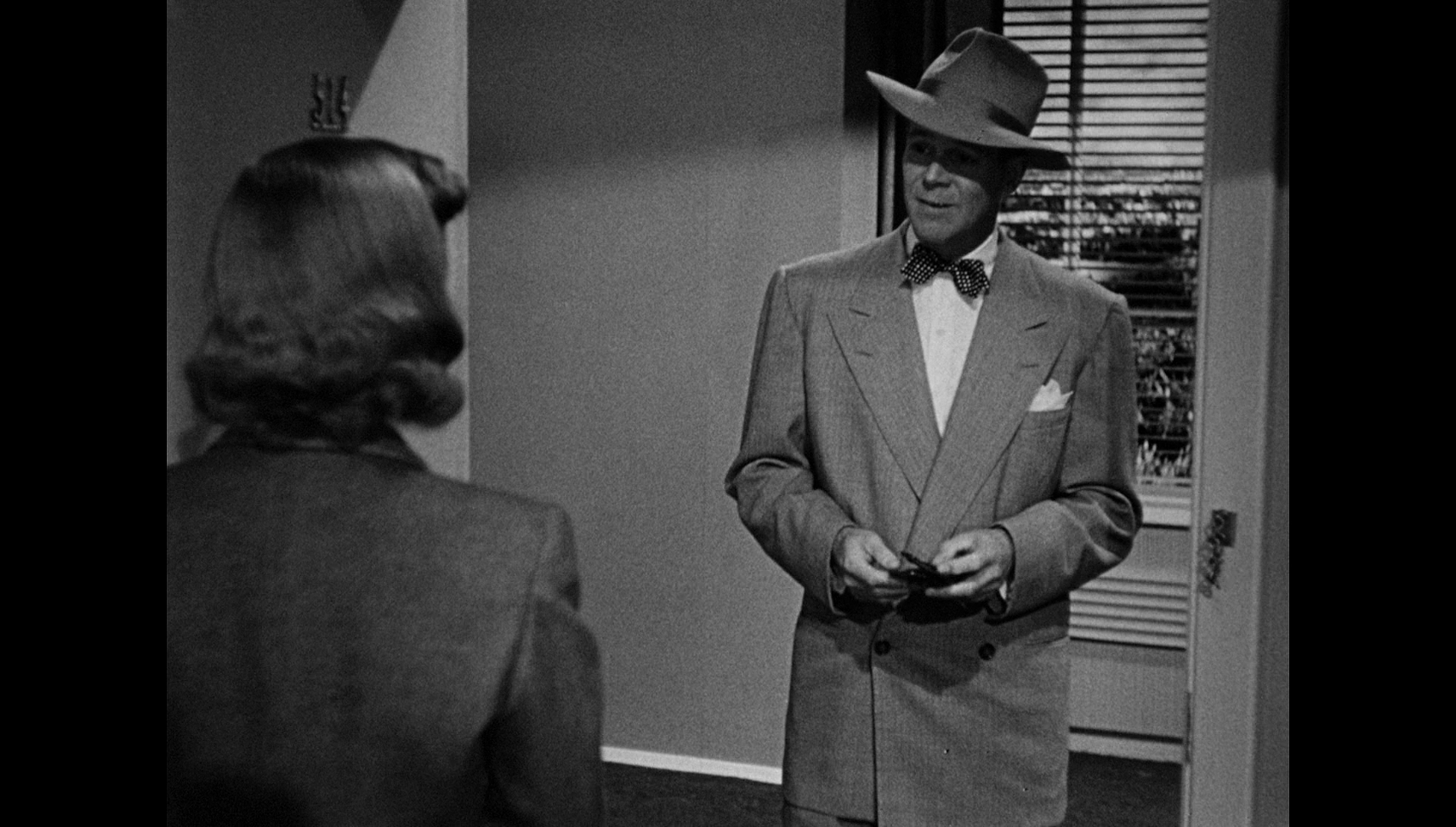 The contrast between Jane and Alan is established at the outset, even before the bag of money is thrown into their car. Alan is happy to be on his way to visiting their friends, Ralph and Ralph’s unnamed wife. However, Jane complains that she hates being patronised by Ralph’s ‘diamond studded wife looking down her nose at me like… like her big ugly house up there looks down on Hollywood’. Jane’s comments point to the flaw in her character which leads to her becoming enmeshed in violence following the death of Alan: a concern with how she is regarded by other people and a perception that she is looked down upon and regarded as a lesser being owing to her social status and lifestyle. The contrast between Jane and Alan is established at the outset, even before the bag of money is thrown into their car. Alan is happy to be on his way to visiting their friends, Ralph and Ralph’s unnamed wife. However, Jane complains that she hates being patronised by Ralph’s ‘diamond studded wife looking down her nose at me like… like her big ugly house up there looks down on Hollywood’. Jane’s comments point to the flaw in her character which leads to her becoming enmeshed in violence following the death of Alan: a concern with how she is regarded by other people and a perception that she is looked down upon and regarded as a lesser being owing to her social status and lifestyle.
Jane is materialistic. Alan is Jane’s second husband. She married her first husband, Blanchard, for money, and she resents Alan for not being able to give her a similar standard of living. However, Blanchard’s death – apparently a suicide, though some believe it to be more than that – is a mystery, coming after he encountered financial difficulties. Jane fails to listen to Alan’s warning that the money will ‘never be safe. It just won’t work’. Alan asks her, ‘What is it, Jane? I don’t understand you. I’ve tried to give you everything I could’. In response to this, Jane bitterly asserts, ‘Yes, you’ve given me a dozen down payments and installments for the rest of our lives’. Later in the film, Jane tells Alan in reference to the money, ‘I’ve been waiting for it, dreaming of it. Even when I was a kid, and it wasn’t because we were poor – not hungry poor, at least. I suppose in a way it was worse. We were white collar poor, middle class poor; the kind of people that don’t quite keep up with the Joneses and die a little every day because they can’t’. Jane says she married Blanchard, her first husband, because he was ‘the first man who asked me [and] he had money’. Alan, on the other hand, has a different perspective on the money: ‘The money won’t help’, he says, ‘There’ll always be Joneses with a little more. The only thing worth having is peace of mind, and money can’t buy that’.
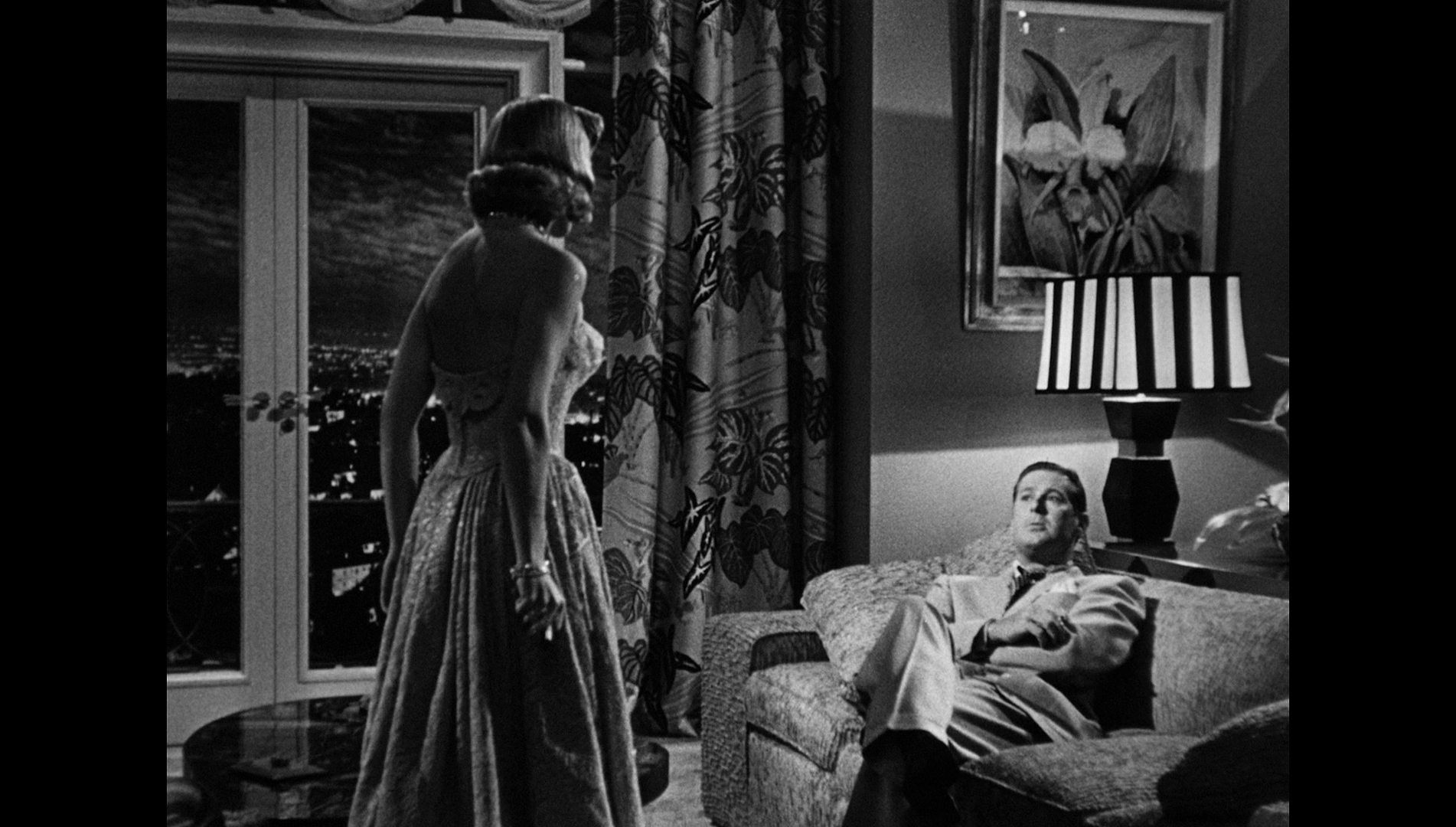 The money acts as a catalyst for the escalation of their differences of opinion, which results in Jane killing Alan – accidentally, she tells Fuller, though the audience might doubt this. After the money has been transferred into their car accidentally, and realising that another car is following them, Jane takes over the wheel and drives recklessly and at speed to escape. Alan reacts with shock: ‘Jane, what are you trying to do?’, he asks. Alan suggests handing the money over to the police, but Jane resists firmly: ‘The money was literally thrown into our laps’, she reasons, ‘No one knows we have it’. Fundamentally, for Jane, the absence of witnesses is a valid reason for keeping the money, regardless of where it may have come from – and, as Alan surmises, ‘That was a payoff. Probably blackmail’. Later, he reminds her ‘We’ve got as much right to that money as if we walked into a bank and lifted a bagful right off the counter’. However, the voice of Alan’s conscience falls upon deaf ears. Later, after the couple have agreed to compromise and place the money in safe storage at the train station, Jane asserts her position more firmly. She tells Alan, ‘I’ll take the money and go off by myself before I let you give it away’. Alan reminds her that ‘I’m in this now. If you’re caught […] I’m caught’. He informs her, ‘The money won’t buy you anything. It’ll only make you miserable and unhappy’. The money acts as a catalyst for the escalation of their differences of opinion, which results in Jane killing Alan – accidentally, she tells Fuller, though the audience might doubt this. After the money has been transferred into their car accidentally, and realising that another car is following them, Jane takes over the wheel and drives recklessly and at speed to escape. Alan reacts with shock: ‘Jane, what are you trying to do?’, he asks. Alan suggests handing the money over to the police, but Jane resists firmly: ‘The money was literally thrown into our laps’, she reasons, ‘No one knows we have it’. Fundamentally, for Jane, the absence of witnesses is a valid reason for keeping the money, regardless of where it may have come from – and, as Alan surmises, ‘That was a payoff. Probably blackmail’. Later, he reminds her ‘We’ve got as much right to that money as if we walked into a bank and lifted a bagful right off the counter’. However, the voice of Alan’s conscience falls upon deaf ears. Later, after the couple have agreed to compromise and place the money in safe storage at the train station, Jane asserts her position more firmly. She tells Alan, ‘I’ll take the money and go off by myself before I let you give it away’. Alan reminds her that ‘I’m in this now. If you’re caught […] I’m caught’. He informs her, ‘The money won’t buy you anything. It’ll only make you miserable and unhappy’.
Jane sees the money as the solution to their problems: ‘We could make it work for us’, she tells Alan, ‘the rest of our lives’. ‘Stop it, Jane’, Alan responds, ‘If we don’t report it, it’s a felony. The same as stealing. It’s a blind alley, with a big barred gate at the end’. However, Jane presses Alan to co-operate with her, much as later in the film she presses Fuller to help her cover up Alan’s death and to commit another murder – and, like Alan, Fuller reminds her of the potential penalty (the gas chamber) for the crimes Jane is asking him to commit but, again like Alan before him, eventually relents and gives in to her demands.
 In these early scenes, the gender roles within the Palmer marriage are subtly reversed: Jane taking over the wheel, driving recklessly and demanding that Alan co-operate with her to keep the money. When a policeman stops the Palmers for speeding as they are returning home with the bag of money, the policeman notices that Alan is nervous, whist Jane has nerves of steel. ‘You’re nervous, Mac’, the policeman observes, ‘It’s the bride that’s supposed to be jittery’. Not long after, Jane and Alan speak with Alan’s sister Kathy, who jokes about the ‘man shortage’. In these early scenes, the gender roles within the Palmer marriage are subtly reversed: Jane taking over the wheel, driving recklessly and demanding that Alan co-operate with her to keep the money. When a policeman stops the Palmers for speeding as they are returning home with the bag of money, the policeman notices that Alan is nervous, whist Jane has nerves of steel. ‘You’re nervous, Mac’, the policeman observes, ‘It’s the bride that’s supposed to be jittery’. Not long after, Jane and Alan speak with Alan’s sister Kathy, who jokes about the ‘man shortage’.
When Fuller meets Jane for the first time, he dominates her, asking her aggressively – in reference to the money – ‘So, you’ve already started spending it, huh?’ He then demands, ‘Where’s my dough?’, before slapping Jane. In their next encounter, Fuller tells Jane ‘You know, honey, you got quite a flair. I like you. Too bad you’re a chiseler’. Clearly intending to placate Fuller, Jane kisses him. Fuller holds her chin in mock good humour before spitefully pushing her away. ‘That’s just a reminder, honey’, he tells her as he does this, ‘You’re in a tough racket now’. However, as the narrative progresses and he becomes more and more enmeshed in Jane’s scheme to cover up the death of her husband, Jane’s demands reduce Fuller to a quivering wreck.
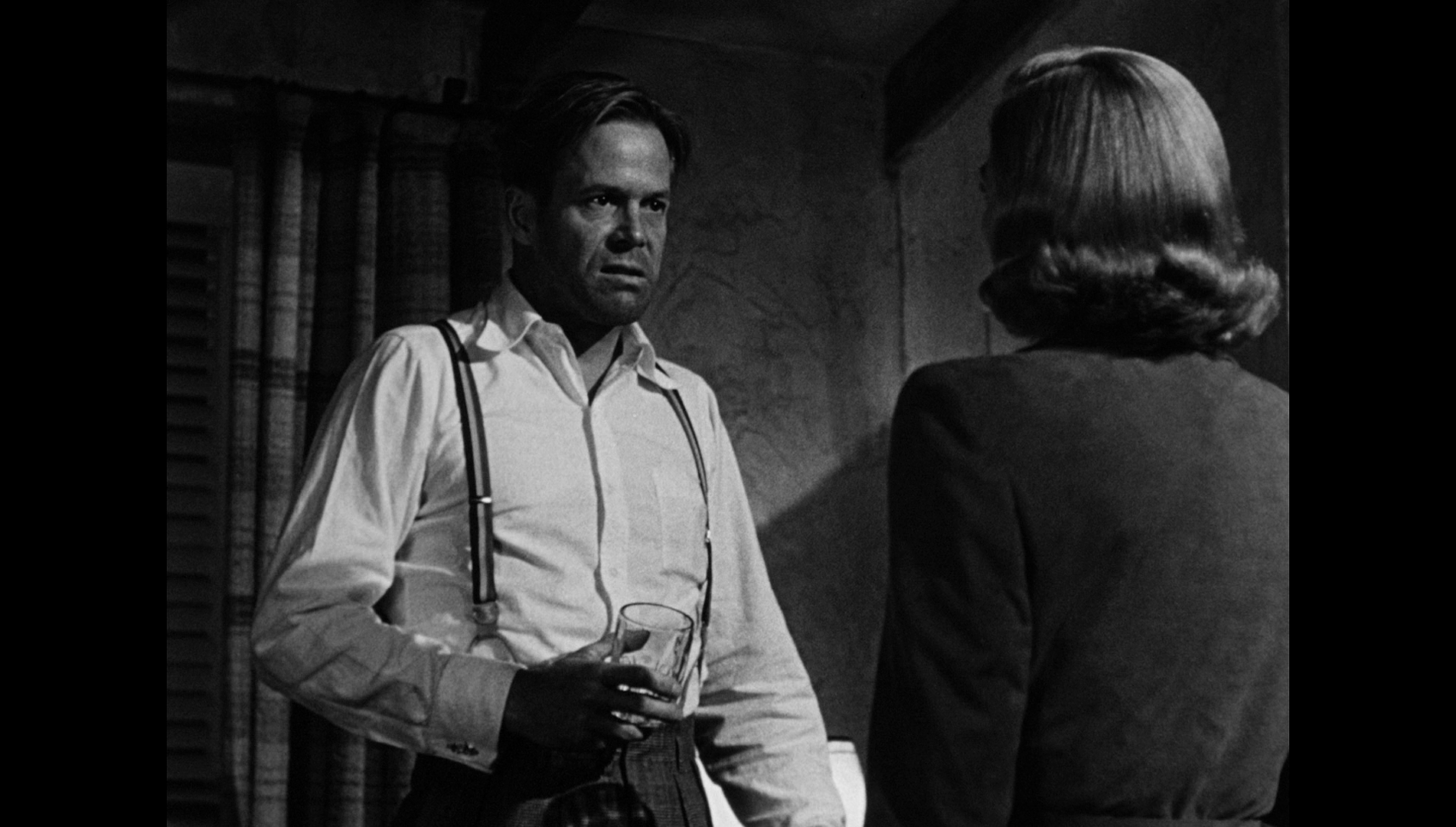 Fuller is a hood, but not a violent hood: a blackmailer, he blanches at becoming involved in covering up a murder. ‘I don’t want the money that bad’, he says cautiously when Jane asks him to help her cover up Alan’s death. The offhand pet names with which Fuller addresses Jane (‘tiger’, ‘honey’) hint at the different aspects of her personality: sweet like honey, vicious like a wild tiger. When Jane attempts to arrange a meeting with him, Fuller’s response suggests he believes he may be next on the list of victims: ‘I’ll see you when it’s daylight and there’s a million people around’, he says. Fuller becomes obsessed with the penalties for the crimes in which Jane is involving him, reminding her that by helping her to cover up Alan’s death, he would become an accomplice to murder and this would put him in line for the death penalty. He begs and pleads to be exempt from her plans: when she orders him to buy poison with which she intends to kill Kathy, thus involving him in another murder, he resists firmly but ultimately acquiesces. Jane persuades him by effectively gaslighting him, telling him that committing another murder is the only way in which they may be able to escape from the shadow of Alan’s death: ‘I didn’t mean to kill Alan’, she says, ‘but it’s done and now it’s our lives against hers [Kathy’s]’. ‘You are a tiger’, Fuller responds, ‘You got me in so deep, I can’t get out’. Finally, Jane confronts Fuller: he has become a drunken wreck. He reveals the nature of the blackmailing scheme which was the source of the money. At the end of the final conversation between Fuller and Jane, Fuller says sarcastically, ‘Here’s to crime. It pays… and pays’. Fuller is a hood, but not a violent hood: a blackmailer, he blanches at becoming involved in covering up a murder. ‘I don’t want the money that bad’, he says cautiously when Jane asks him to help her cover up Alan’s death. The offhand pet names with which Fuller addresses Jane (‘tiger’, ‘honey’) hint at the different aspects of her personality: sweet like honey, vicious like a wild tiger. When Jane attempts to arrange a meeting with him, Fuller’s response suggests he believes he may be next on the list of victims: ‘I’ll see you when it’s daylight and there’s a million people around’, he says. Fuller becomes obsessed with the penalties for the crimes in which Jane is involving him, reminding her that by helping her to cover up Alan’s death, he would become an accomplice to murder and this would put him in line for the death penalty. He begs and pleads to be exempt from her plans: when she orders him to buy poison with which she intends to kill Kathy, thus involving him in another murder, he resists firmly but ultimately acquiesces. Jane persuades him by effectively gaslighting him, telling him that committing another murder is the only way in which they may be able to escape from the shadow of Alan’s death: ‘I didn’t mean to kill Alan’, she says, ‘but it’s done and now it’s our lives against hers [Kathy’s]’. ‘You are a tiger’, Fuller responds, ‘You got me in so deep, I can’t get out’. Finally, Jane confronts Fuller: he has become a drunken wreck. He reveals the nature of the blackmailing scheme which was the source of the money. At the end of the final conversation between Fuller and Jane, Fuller says sarcastically, ‘Here’s to crime. It pays… and pays’.
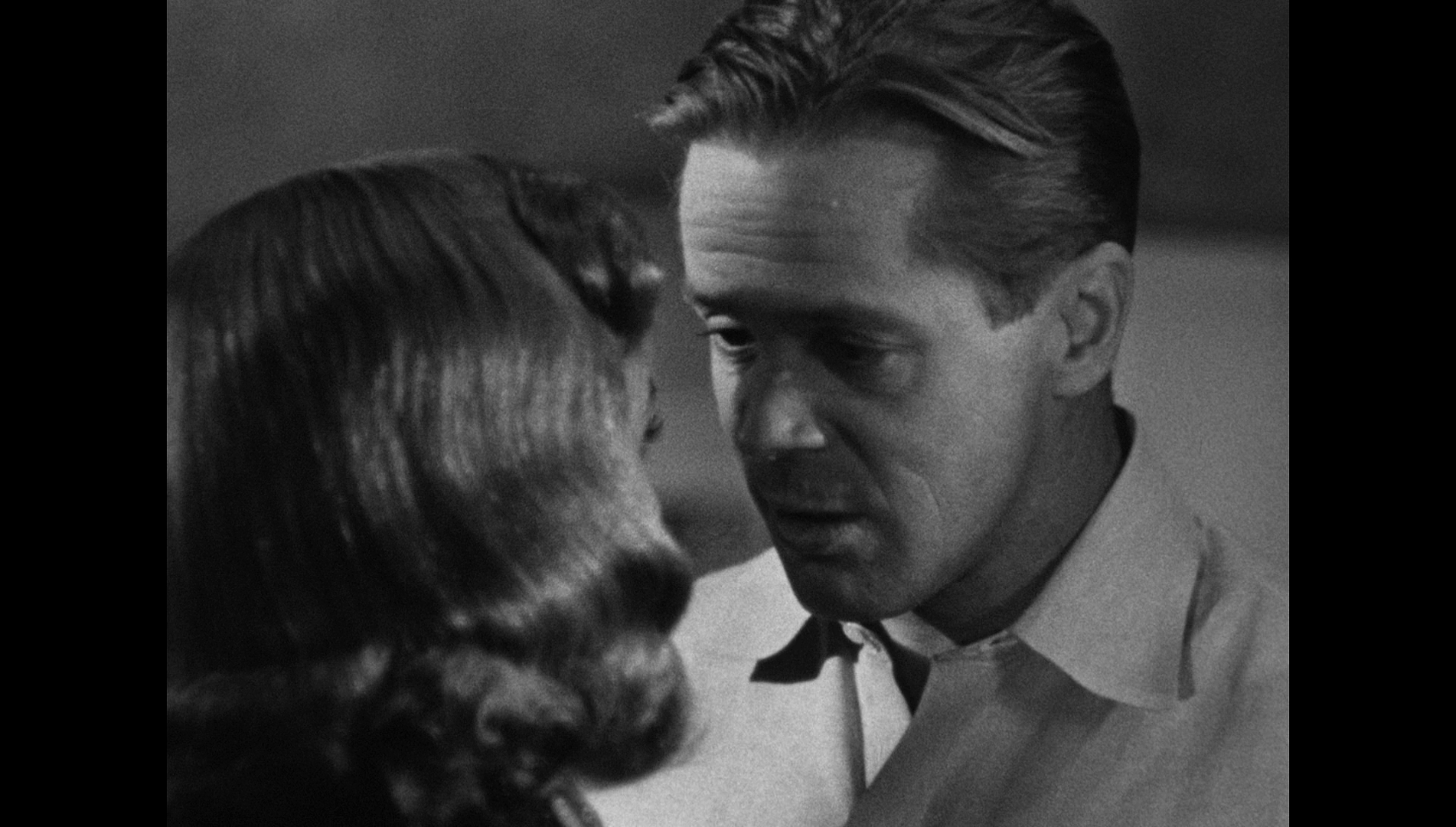  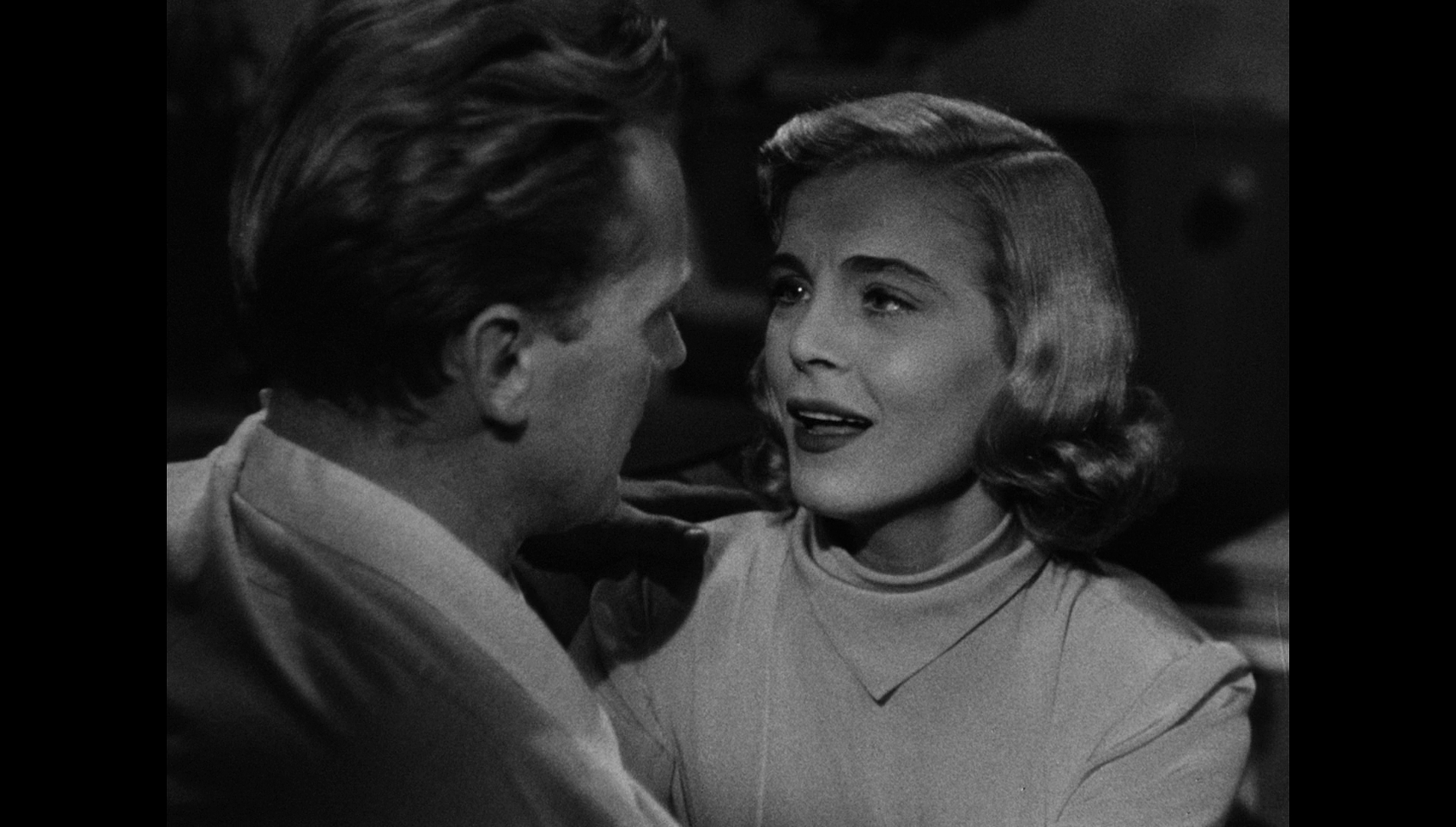
Video
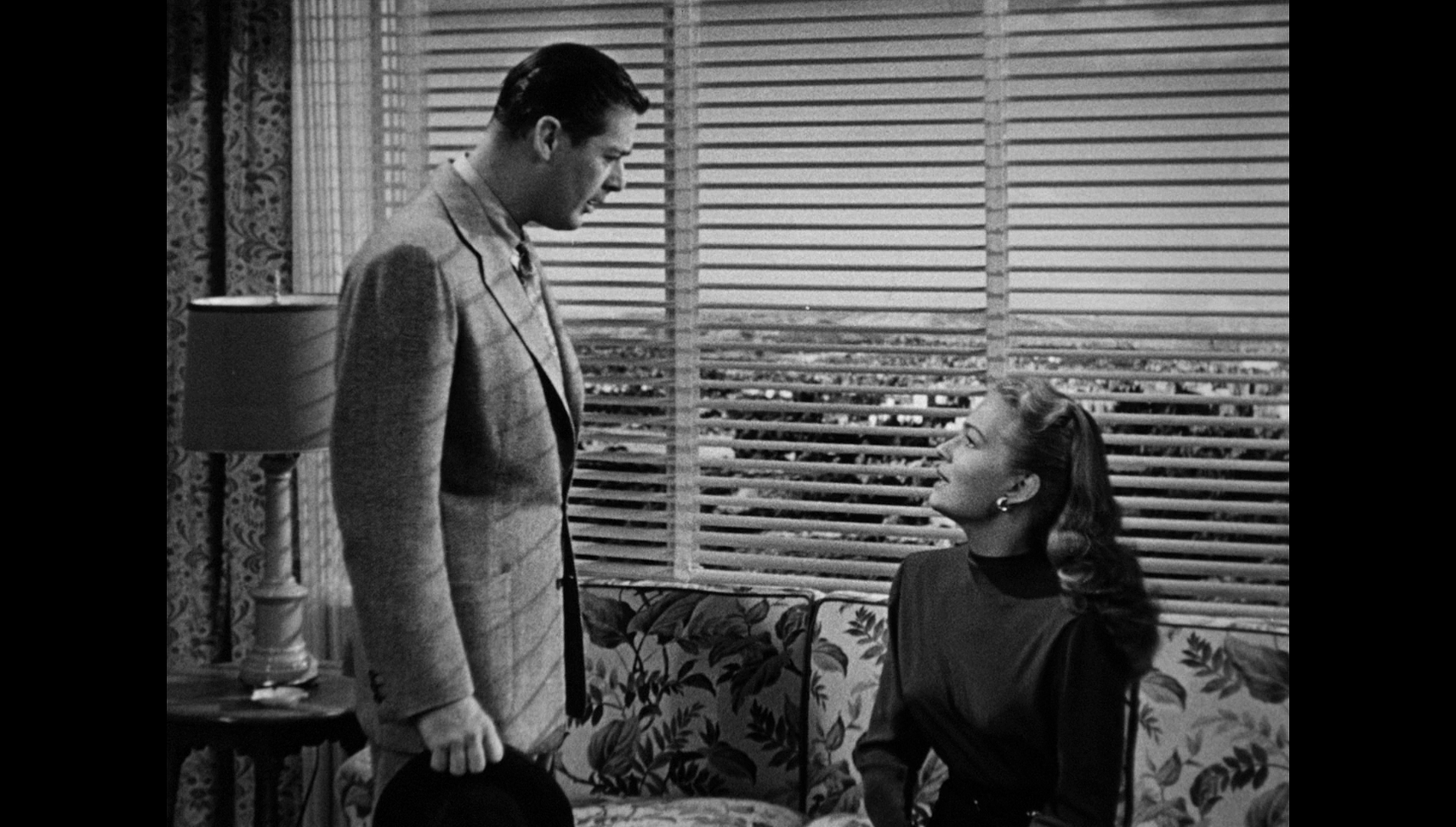 Taking up a little over 20Gb of space on the disc, the 1080p presentation of Too Late for Tears uses the AVC codec and is in the film’s original aspect ratio of 1.33:1. Taking up a little over 20Gb of space on the disc, the 1080p presentation of Too Late for Tears uses the AVC codec and is in the film’s original aspect ratio of 1.33:1.
The film is uncut, running for 101:10 mins. The presentation is essentially a composite, with the bulk of the presentation based on a 35mm dupe negative that was held in France (under the French title La tigresse), with the titles sequence reconstructed (new computer-generated titles are presented in what the information in the booklet asserts are the ‘correct fonts’ over the plates used for the titles sequence). From this 35mm dupe negative, the UCLA created an answer print, then a release print and an archival fine grain master; from this fine grain master, the 2k scan used as this basis for this presentation was struck. However, some scenes in the 35mm dupe negative exhibited major damage, and to cover this material was patched in from a 35mm reissue print (from the 1955 US reissue of the film, which was titled Killer Bait). Sometimes this material is patched into the presentation in the middle of shots, resulting in noticeable shifts in contrast levels and image quality – with the material from the Killer Bait print source displaying bolder contrast and a coarser grain structure, both of which are commensurate with the fact that this material comes from a print that is another few generations removed from the negative source.
The bulk of the presentation is excellent, with very good contrast levels: defined midtones are balanced by the deep blacks associated with the photography of classic films noir. As in many films noir, many shots are staged in deep focus; there’s a pleasing sense of depth to the presentation here, and an excellent level of detail. The presentation retains the structure of 35mm film, and is as organic and filmlike as a digital simulacrum of a picture shot on 35mm film can be. Some density fluctuation in the emulsions can be seen in some scenes, and as noted above there are noticeable ‘jumps’ in quality where shots have been patched in from the Killer Bait print – in which contrast is quite different and the structure more coarse.
In all, it’s an excellent, pleasing presentation; the damage exhibited here is organic and commensurate with the age of the materials. This is as complete and pleasing a presentation as we’re ever likely to get.
Audio
Audio is presented via a LPCM 1.0 mono track, which is accompanied by optional English subtitles for the Hard of Hearing. This track is mostly sourced from the aforementioned 1955 reissue print, with some material coming from a 16mm print source. The track is clear and audible throughout, with good range. Some ‘rasp’ is present at stages throughout the track, but once again this is commensurate with the age and rarity of the materials used for this presentation.
Extras
The disc includes:
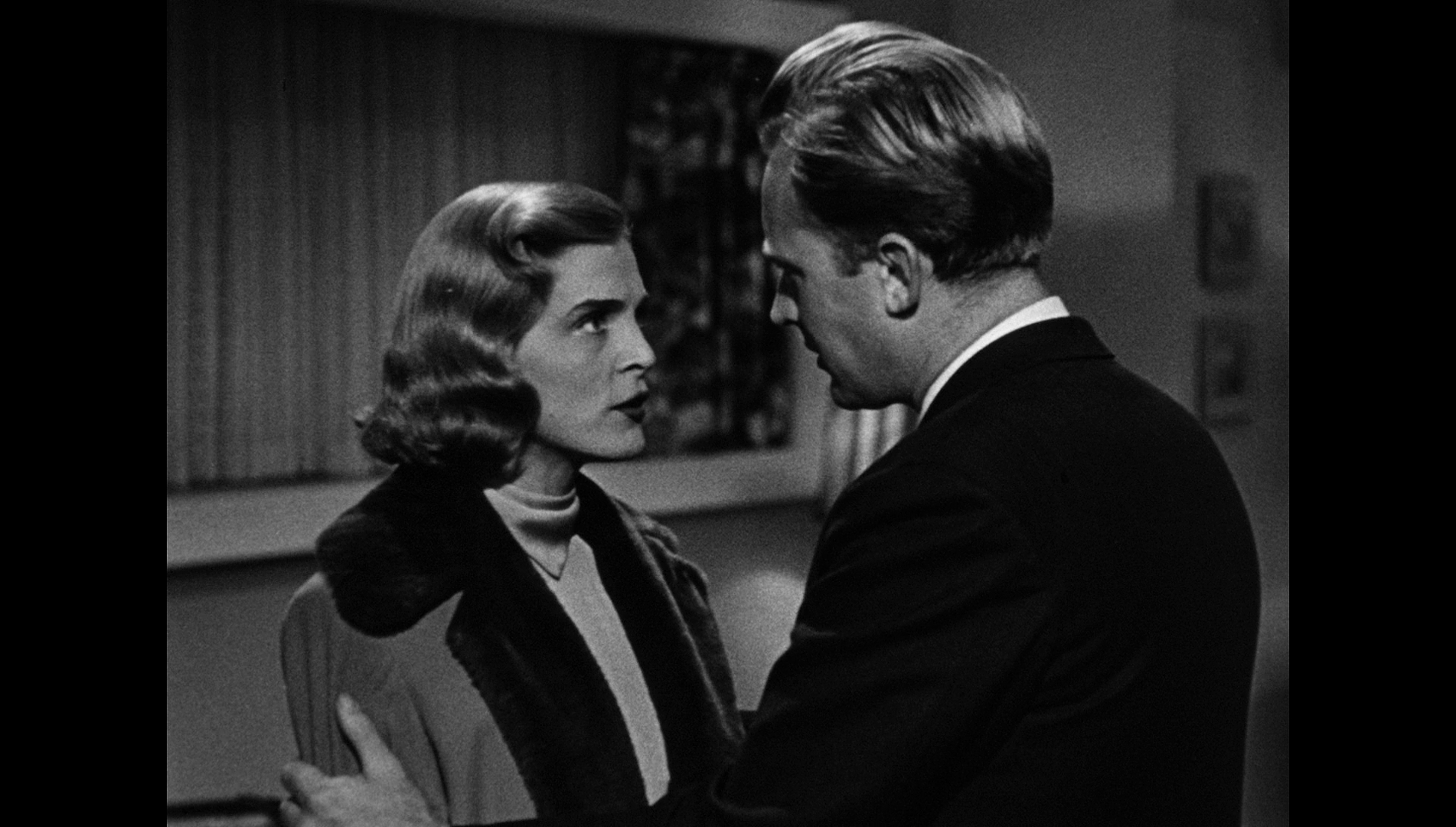
- an audio commentary with film historian Alan K Rode. In this excellent commentary, Rode discusses the film’s production context, its genesis and its impact. Its origins in Roy Huggins’ novel Too Late for Tears is commented upon, and the film’s themes are explored.
- ‘Chance of a Lifetime: The Making of Too Late for Tears’ (16:26). Made for the Film Noir Foundaiton, this featurette explores the history of Too Late for Tears. It features interviews with film historians Eddie Muller, Julie Kirgo, Alan K Rode and Dan Duryea’s son Richard Duryea. Some comments from Lizabeth Scott are provided in the form of audio snippets from a 2010 interview with the actress.
Muller says that Duryea plays ‘the same sleazeball he plays in all his movies, but it’s a different, more unique take on that character’. Kirgo argues that the film is about ‘an average, middle class woman’s relationship with money’. The main parts were originally intended for Joan Crawford, Kirk Douglas and Wendell Corey. Ultimately, the budget was cut to accommodate the salaries of Lizabeth Scott and Dan Duryea. Muller says ‘people are aghast’ at how devious Jane is in the film, but the irony is that she’s an ‘all-American housewife’. ‘She [Jane] could go from this to a John Waters movie almost instantly’, Muller says. The death of Alan is ‘really sad […] because he is like the only normal person in the film’. Muller says that Duryea ‘made malevolent evil really squirmingly entertaining’, and when Richard Widmark tired of playing these kinds of characters, Duryea ‘embraced it’. Fuller is described as a ‘conflicted’ and ‘kind man who does have a heart’. Kirgo suggests that ‘By the end he’s sickened by what she’s driven him to do’. Kirgo suggests that in its representation of crime and Jane’s immersion in it (or rather, her role as its catalyst), the film is an ‘antidote’ to the television movie staples of afternoon programming.
- ‘Tiger Hunt: Restoring Too Late for Tears’ (4:30). Made for the Film Noir Foundation, this featurette examines the restoration of the film. Scott MacQueen, Alan K Rode and Eddie Muller discuss how the film was restored. Muller suggests he had a lead in tracking down a private owner of a 35mm print and a number of other films that this man kept in storage, but the man died prior to a deal being made. MacQueen talks about the restoration of the film’s titles – based on the Killer Bait print’s opening titles sequence, which had the titles rotoscoped out and turned into a background plate over which new opening titles in the font of the originals were presented. This was done as an alternative to splicing in the titles sequence from a 16mm source. The final shot, a freeze frame, was duplicated in a similar manner.
- Stills gallery (0:20).
Retail copies include an excellent booklet which details the restoration and contains a new article about the film by Brian Light and entitled ‘It’s Never Too Late’. Light’s piece reflects on the source novel by Roy Huggins and the changes that were made to it in the film’s script. It’s illustrated throughout by some beautiful monochrome stills from the film.
Overall
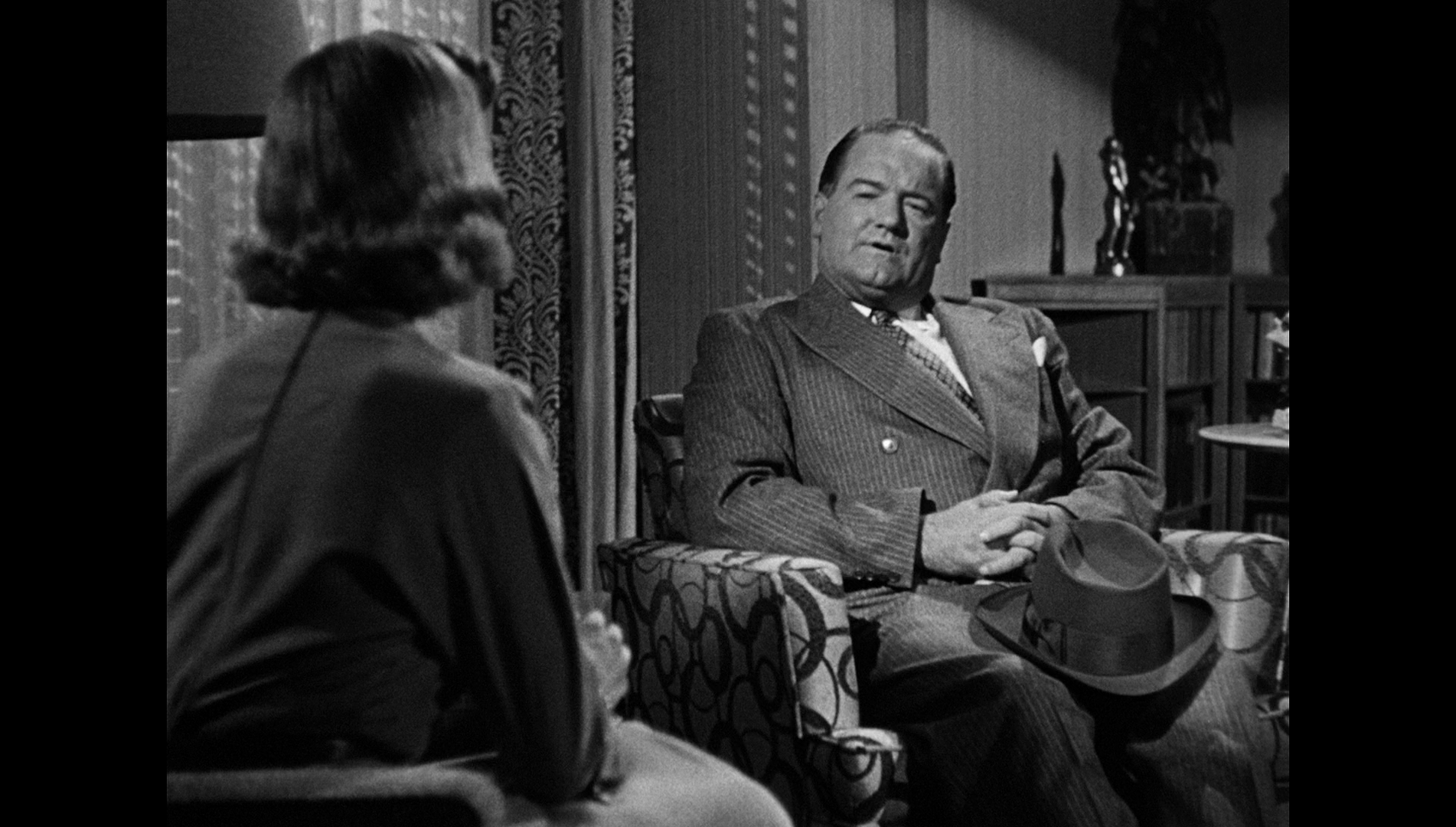 A fascinating example of the American film noir in its classic phase, Too Late for Tears is anchored by excellent performances from Scott, Kennedy and especially Duryea. The film’s depiction of the poisonous effects of the bag of cash that falls into Jane and Alan’s lap feels deeply subversive, and is made more so by the escalation of events that is caused by Jane’s concern with wealth and status. It’s a dark, thrilling take on the ‘keeping up with the Joneses’ phenomenon that feels as relevant today as it would have been during its initial release. The film is filled with subtle ironies, such as the fact that the gun with which Jane kills Alan is in fact Alan’s own service revolver – as Kathy says, the only object Alan ‘loves’, a memento of his service during the Second World War. This revelation, which comes relatively late into the film, ensures that the viewer doesn’t see Alan as Jane’s ‘patsy’, and also locates the film within the group of films noir made in the post-war years that explore the trauma of the cultural fallout from the war itself. A fascinating example of the American film noir in its classic phase, Too Late for Tears is anchored by excellent performances from Scott, Kennedy and especially Duryea. The film’s depiction of the poisonous effects of the bag of cash that falls into Jane and Alan’s lap feels deeply subversive, and is made more so by the escalation of events that is caused by Jane’s concern with wealth and status. It’s a dark, thrilling take on the ‘keeping up with the Joneses’ phenomenon that feels as relevant today as it would have been during its initial release. The film is filled with subtle ironies, such as the fact that the gun with which Jane kills Alan is in fact Alan’s own service revolver – as Kathy says, the only object Alan ‘loves’, a memento of his service during the Second World War. This revelation, which comes relatively late into the film, ensures that the viewer doesn’t see Alan as Jane’s ‘patsy’, and also locates the film within the group of films noir made in the post-war years that explore the trauma of the cultural fallout from the war itself.
Arrow’s presentation, which is a composite of several sources, is very good indeed, and is accompanied by some excellent contextual material. Along with Arrow’s new release of Norman Foster’s Woman on the Run, this disc is an essential purchase for fans of films noir.
References:
Schwartz, Ronald, 2014: Houses of Noir: Dark Visions from Thirteen Film Studios. London: McFarland & Company
Shadolan, Jack, 2003: Dreams and Dead Ends: The American Gangster Film. Oxford University Press
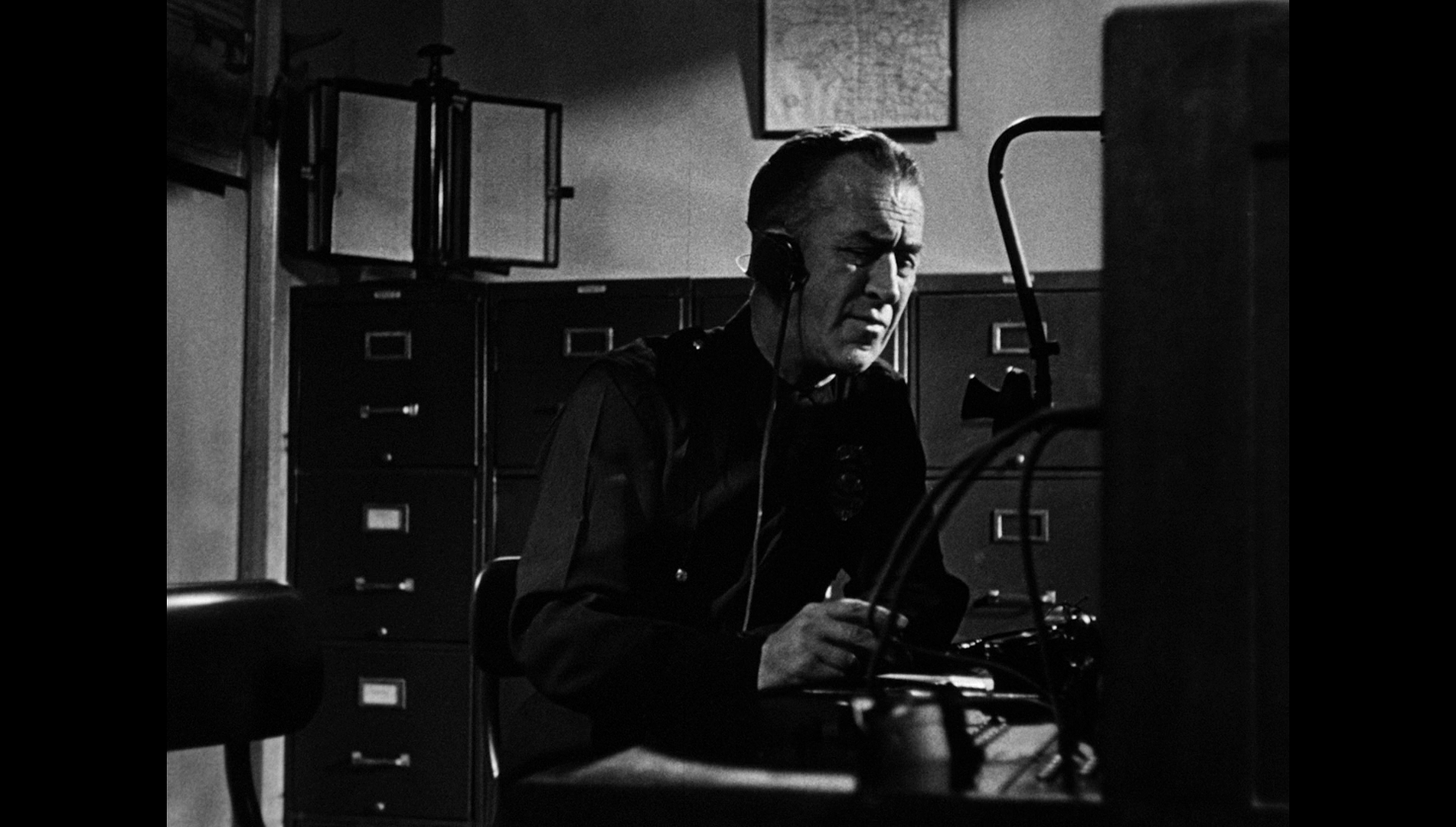
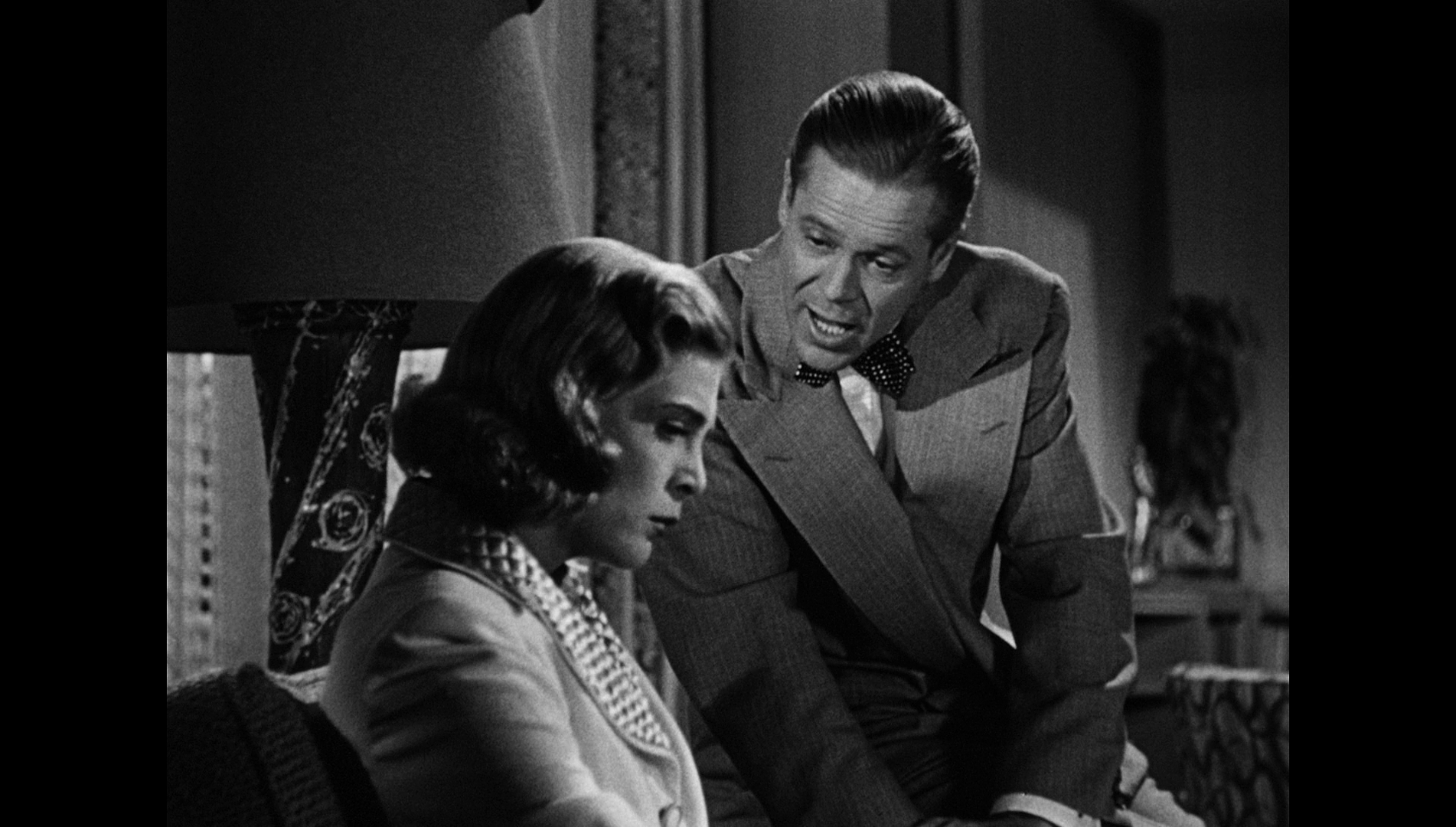
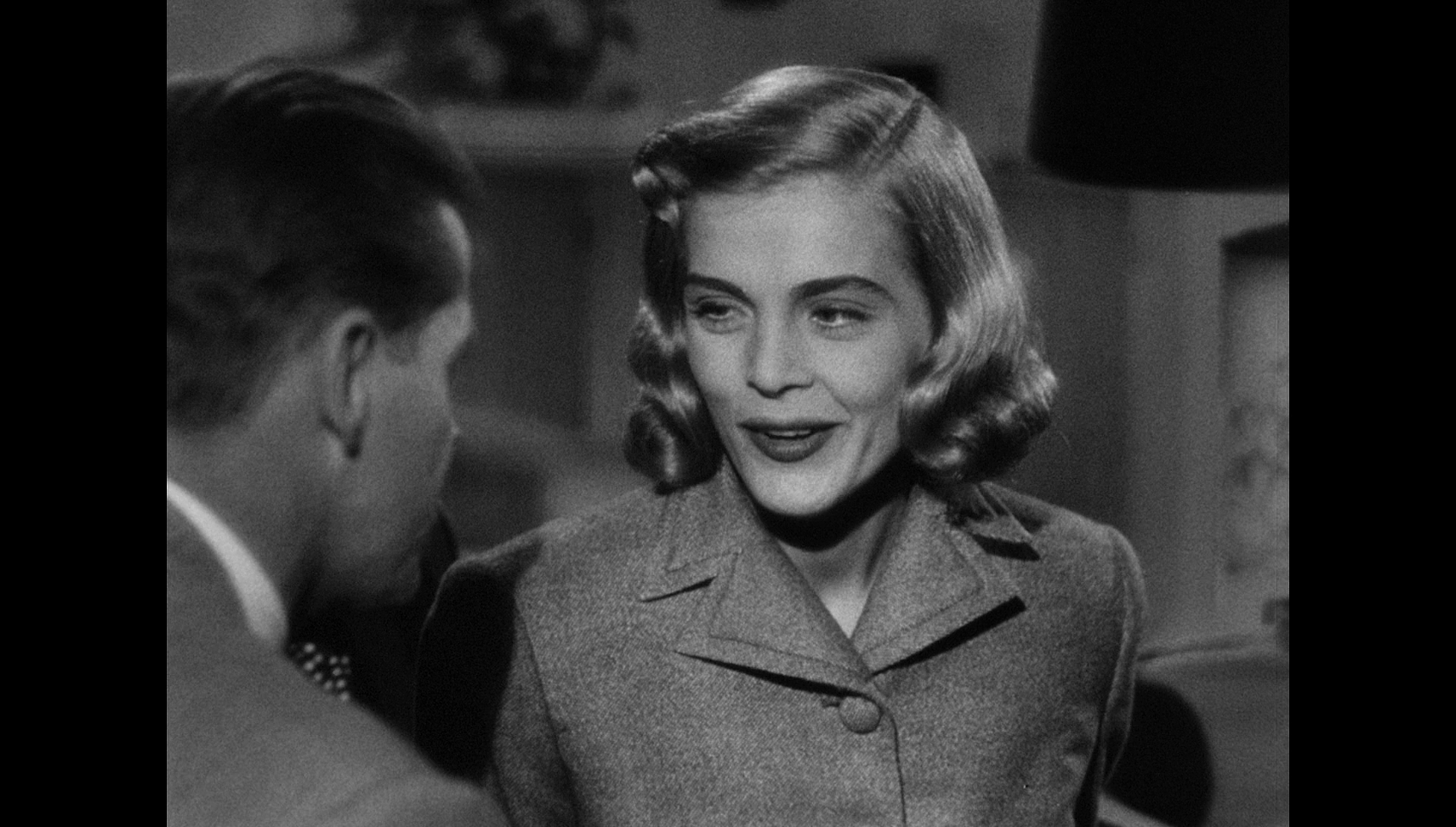
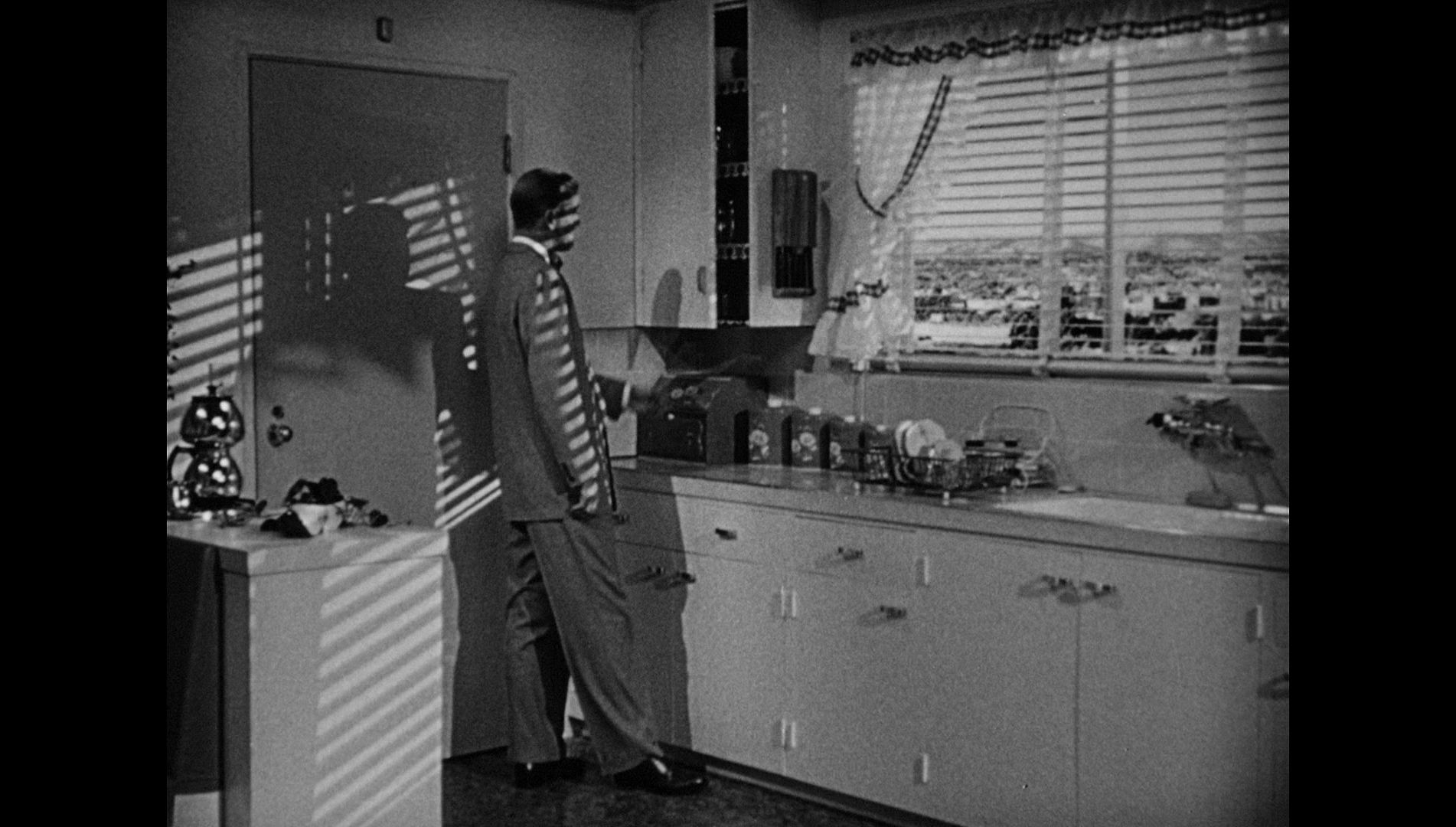
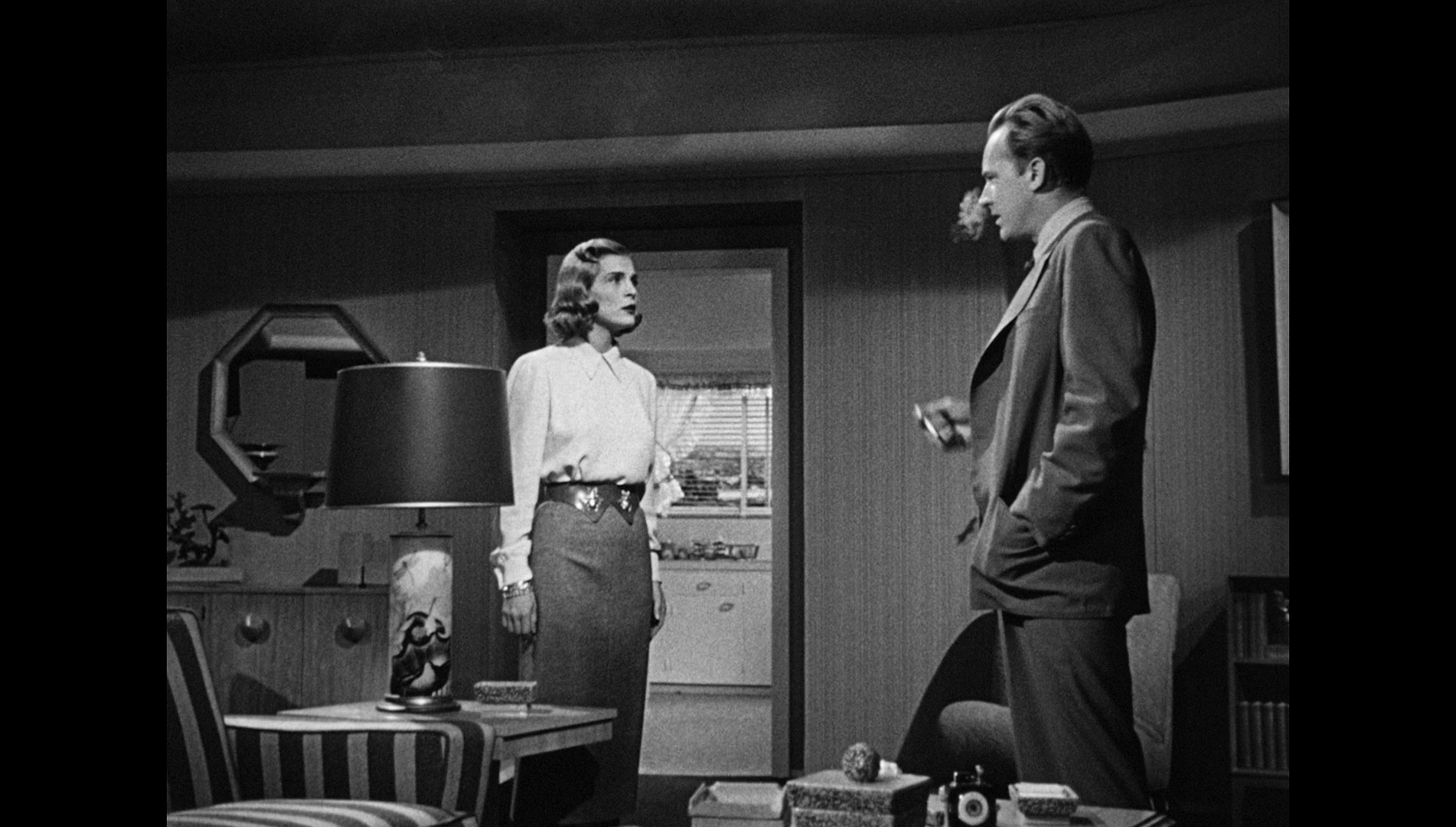
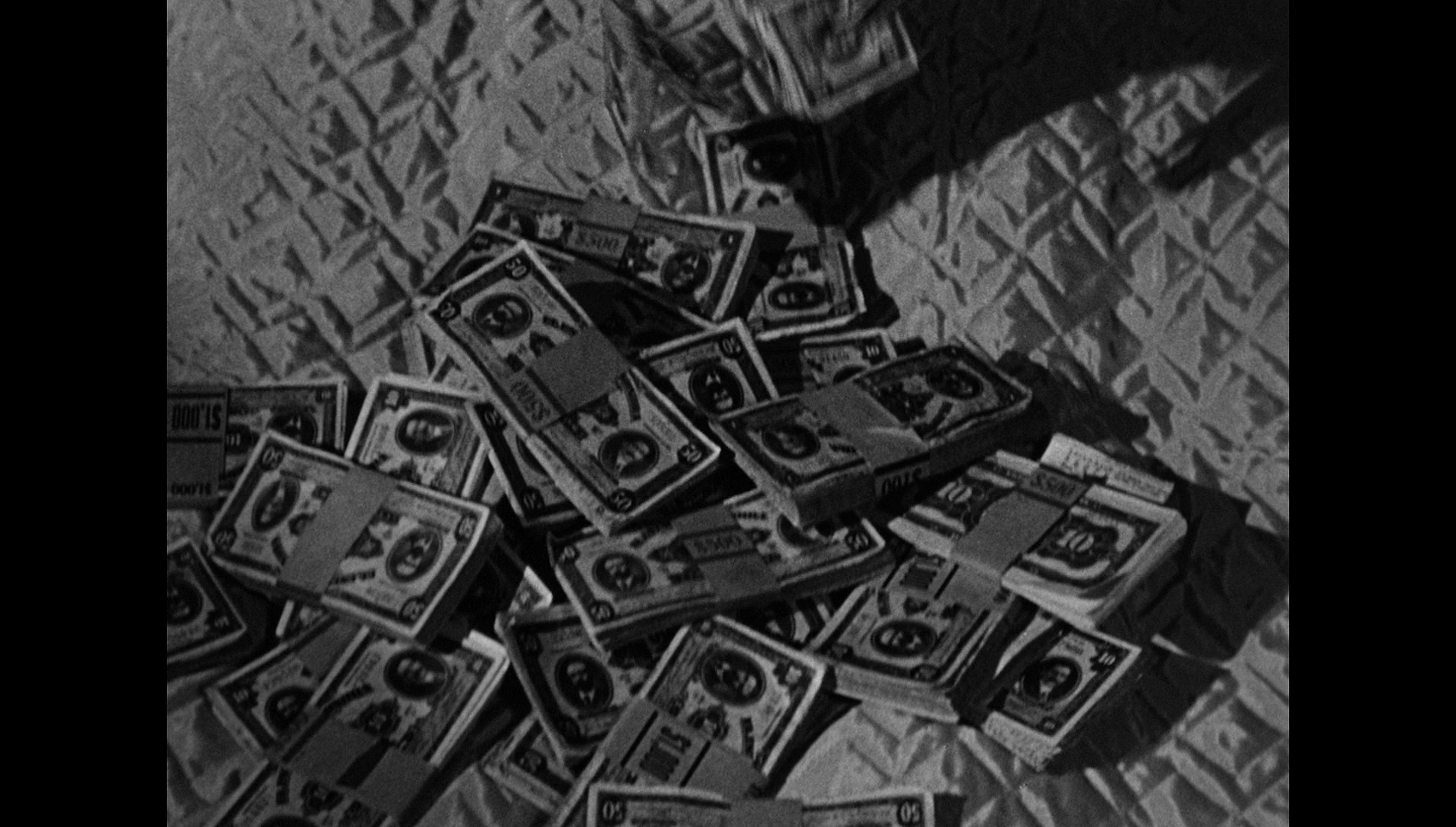
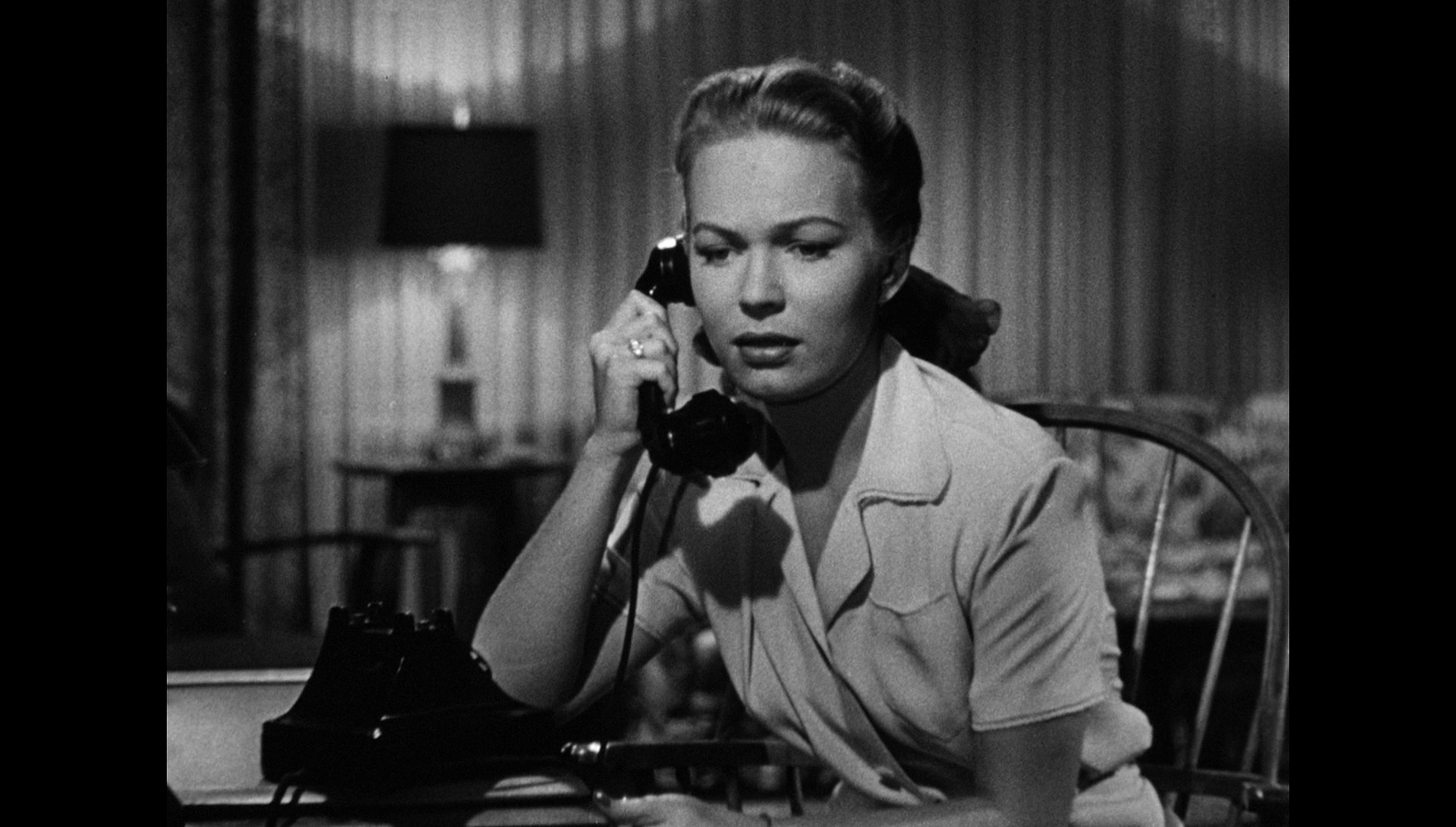
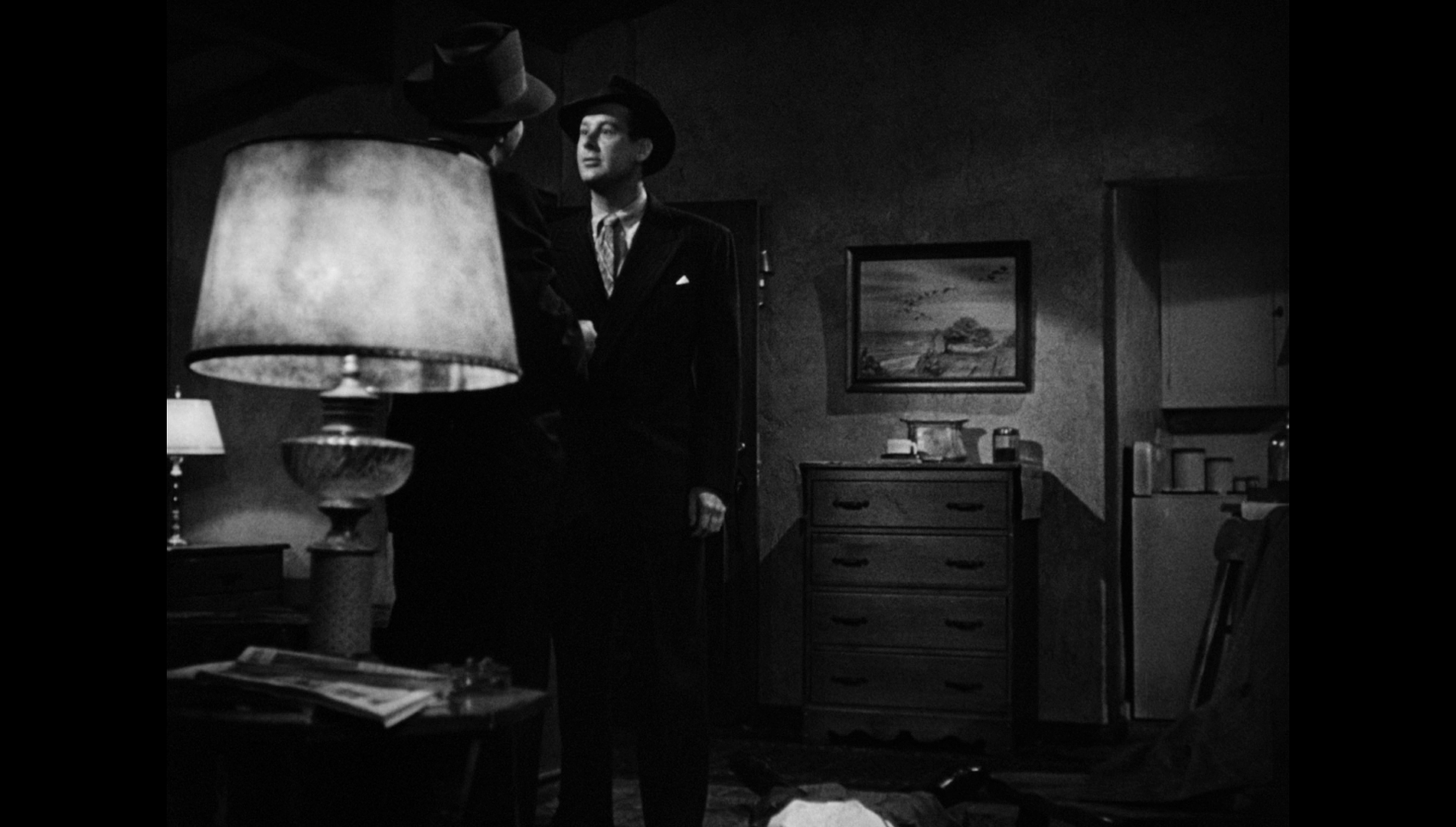
|


